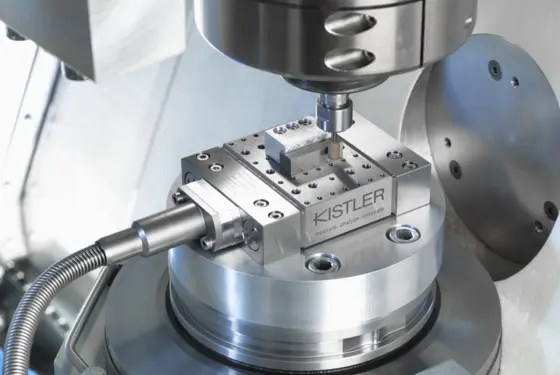How to measure cutting forces in milling processes?
In order to measure forces during milling, both stationary and rotating dynamometers (RCDs) can be used.
How to measure cutting forces in milling processes with a stationary dynamometer?
The stationary dynamometer is mounted on the machine tool table and the workpiece is positioned on top of it. To reduce the mass on the dynamometer and thus minimize the negative influence on its dynamics, the workpiece is bolted directly onto the dynamometer; this eliminates the need for heavy (and often non-rigid) vises.
As displayed in fig. 1 and fig. 2 below, in milling the orthogonal force components feed force Ff, the normal feed force FfN and the passive force Fp can be measured directly with a stationary dynamometer. The active force Fa can be calculated from the measured Ff and FfN. The cutting force Fc and the normal cutting force FcN can also be calculated by using the measured Ff, FfN, and Fz.
Why measure cutting forces in milling processes
A rotating dynamometer (RCD) is inserted directly into the machine spindle, while the tool is connected to the RCD with suitable tool holders (see Fig. 3 and Fig. 4). Because it is connected to the machine spindle, the RCD rotates with it during operation. The installed multi-component sensor makes it possible to measure the spindle moment Mz directly throughout the entire measurement.
While measuring forces with an RCD, the coordinate axis also rotates, but it remains firm when performing measurements with a stationary dynamometer. Please refer to Fig. 3 where the forces Fx and Fy measured with a stationary dynamometer are represented by orange vectors, while Fx and Fy force components measured with an RCD are represented with blue vectors.
When using an RCD, the active force Fa that acts on the working plane can be calculated from forces Fx and Fy. The acting cutting force Fc and the normal cutting force FcN can be calculated with the help of the spindle moment Mz, the radius of the tool, and the active force Fa.
The milling process is a highly dynamic process and thus puts high demands on machine-process stability. By measuring cutting forces one can:
- Understand and optimize the tool performance
- Monitor and reduce machine-process abnormalities
- Understand and compare machinability of different materials
- By monitoring and controlling the forces, production KPIs (such as cost, delivery time, quality, environmental impact) can be improved








